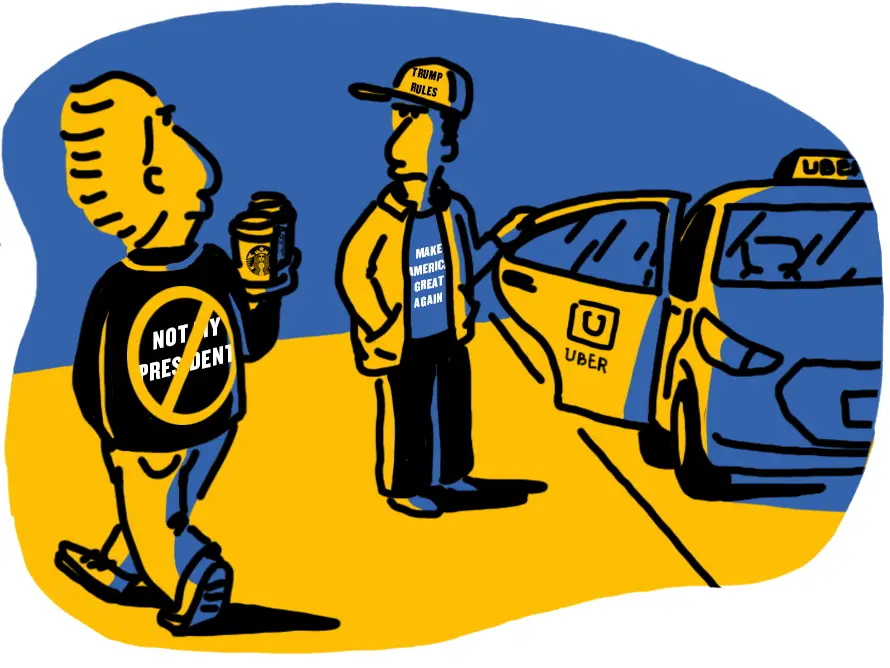Consumer boycotts have been around for decades, ranging from Nestle to Nike, but with America’s current political tensions so taut, nowadays it seems like every other week a different corporation is hit by a social media-rallied boycott.
The recent protests are coming from liberals who oppose President Donald Trump’s executive orders, and conservatives who support them. On paper, the idea of a consumer boycott against a corporation for their stance on a political issue makes sense.
In America’s capitalist system, the most powerful tool of all is the average American and their spending money. So, why not abstain from a company and their political stance, especially with such a controversial figure running the nation?

The origins of the current consumer boycotts began long before Trump was elected. In October 2016, a campaign called “#GrabYourWallet” was made, which listed every company with some sort of dealing with Trump’s businesses, including the selling of Trump products, and was a call for people to refuse to purchase any affiliate products. However, America didn’t experience the real rise of consumer boycotts until a week after the infamous election, when a boycott garnered massive notoriety in the news.
Many Trump supporters called for a movement on social media entitled “#BoycottHamilton.” The online protest was created after the cast of the hit Broadway show “Hamilton” addressed Vice President Mike Pence at the end of the show he attended, and many Trump supporters believed that Pence was unfairly bullied by the cast members.
Meanwhile, in late December, book publisher Simon & Schuster announced they had made a book deal with the controversial “Breitbart” editor Milo Yiannopoulos. When the publishing company announced the news, outrage from many liberal celebrities and activists, as well as literary journals and independent bookstores, demanded that the publishers rescind their offer due to Yiannopoulos’ controversial status.
Both protests now appear to have been economically toothless, as Hamilton is still being performed in sold-out shows and Yiannopoulos will still have his book published. However, both were precursors to a seemingly endless run of boycotts and protests against companies for their political stances on Trump.
The first post-inauguration boycott to receive mass attention was “#DeleteUber,” a movement calling for people to delete their Uber profile after the company seemingly profited off of the New York taxi strike following Trump’s travel ban. Then, just a couple of days later, Trump supporters rallied for a boycott against Starbucks, after the company announced that they would give jobs to over 10,000 refugees within the next five years, instead of employing Americans.

And, soon after, even more companies were hit with a condemnatory hashtag from one of the two major political groups in the U.S. The right fought against Budweiser and Netflix, while the left continued to push “#GrabYourWallet” by fighting against companies such as L.L. Bean, Bloomingdales, Macy’s and hundreds of other retailers.
The reasons for fighting the companies included, but was not limited to: selling Trump products, promoting Ivanka Trump’s fashion line, supporting Trump and/or his business policies or funding his political campaign.
At this point, the barrage of protests seems to have begun collapsing in on itself, with Nordstrom being a prime example. At first, leftists boycotted the upscale retailer as part of the “#GrabYourWallet” campaign, but then, after Nordstrom dropped Ivanka’s products, rightists came along and proceeded to boycott the retailer in a protest against the retailer’s decision.
And yet, as different companies get faced with some sort of political backlash every other day, you have to wonder if the protests actually have any impact on the sales, shares or business practices of companies.
In short, it’s impossible to say just yet. Believe it or not, Trump has only been president for thirty days, and with such a short timeframe, it’s hard to judge how impactful the boycotts have been.
On the pro-Trump side, their efforts appear to be ineffective, as no retailer has taken any considerable hit for ridiculing the president. However, on the anti-Trump side, some definitive progress has been made, such as Nordstrom dropping Ivanka’s clothing and Uber CEO Travis Kalanick leaving Trump’s advisory panel after the “#deleteUber” debacle.
While a good boycott can change the business practices of a company, the constant barrage of different protests has made it hard to sustain pressure on any one company. In the early nineties, when customers first learned of Nike’s immoral labor laws, a sustained opprobrium on the sportswear-maker led them to change their production system. But, the kind of change Nike exhibited will never arrive if the boycotts are so unfocused.
Social media benefits grassroots activism in allowing messages to proliferate further and more quickly than ever, but that same boon can be a bane. The constant call for political action has left consumers dizzy, and even the most devoted wallet anarchists would be hard-pressed to know who exactly they’re supposed to be boycotting at any given moment. As such, outside of a day or two of slumped stocks, many companies will experience few ramifications from the protests.
Still, I have no problems with any of the recent boycotts. Everyone should have the right to protest and fight for what they believe in, even if I myself disagree with what they are fighting for. But I do feel that it is within the best interests of political agitators to keep their focus narrow and sustained, rather than scattershot as it is now.
Strangling one company into bankruptcy sends a much more frightening message than lowering the weekly sales of a dozen retailers.
In other words, if the aim of the boycotts is efficacy, then protestors might actually do well to scale back.












[…] Since releasing the Kaepernick ad, Nike’s sales have risen by 31 percent. How, amid all these boycotts and lost customers, did Nike manage to come out on top? Well, for one thing, they must have had an […]